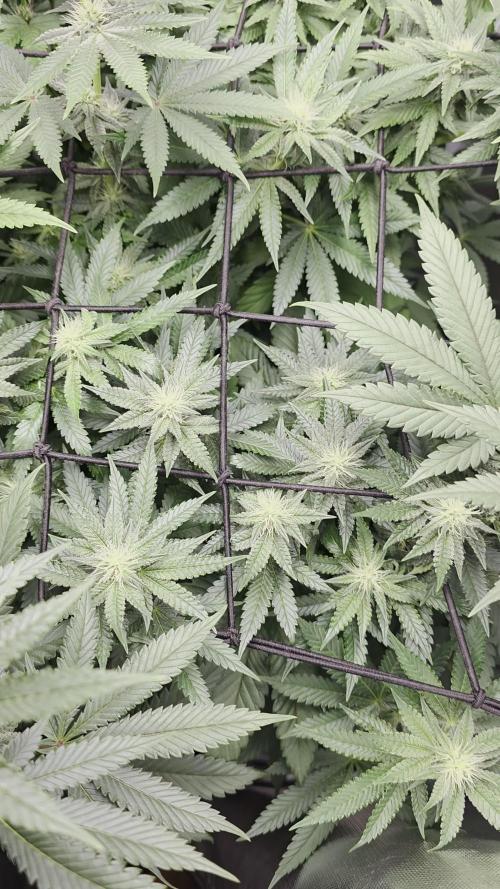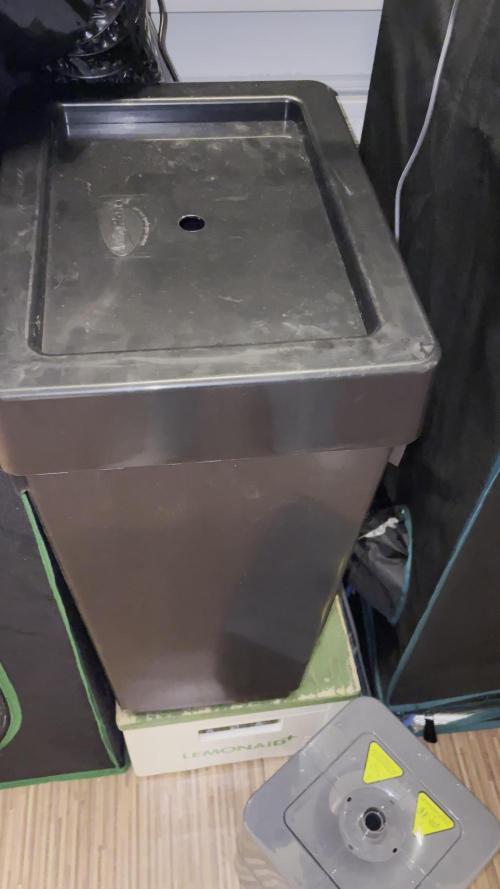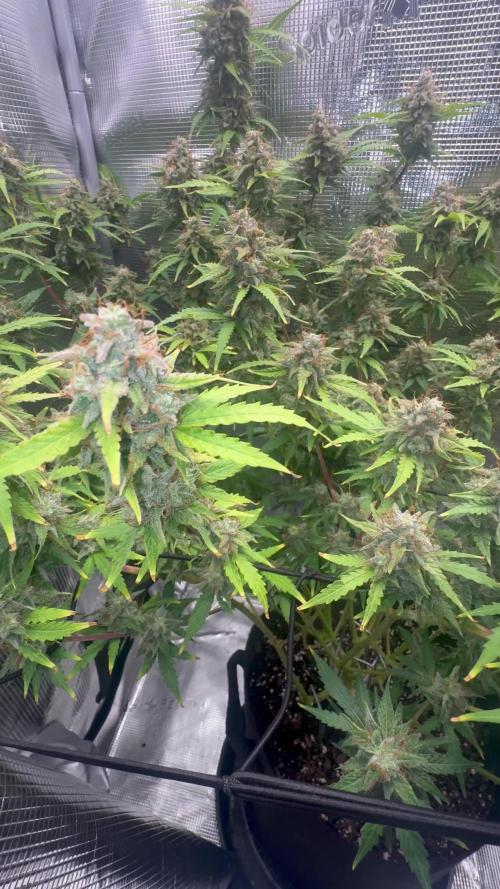The Grow Awards 2026 🏆 





































Likes
Comments
Share

@Shawneyboy85
Follow
This week everything is doing well for the most part, I’m having a Canuk bred strain start to yellow up and get some brown spots on her @day61 and looks like a little bit of calcium deficiency in my mutant lemon pie but I’ll keep on working to get them corrected as best I can
Likes
28
Share


@stevieb21
Follow
This week was solid again. I’m monitoring the two back plants in slightly smaller pots as they are using much less water right now and are also a few days in growth behind their sisters in the larger pots.
Very happy with the growth but I wanted to test the plants tolerance to the light at 36” above the canopy. I simply placed 12” pots under each of them rather than lower the light as I have it in a fixed position right now at the very top of the tent. Plants are responding well...or at least there is no negative response as they are still growing very 💪.
I am constantly LST’ing in order to keep the canopy low and flat. The Durban’s are only at 10” and the Cali’s are at 13”. I broke one top on the Cali Haze but I grafted it back on with some on hand electrical tape. These girls are much tougher to keep low than the Durban’s so I need every branch!
Bumped their feed up to an EC of 1.4 and will continue to increase this week to see how they respond. So far there is no signs of leaf burn.
I’ve pre programmed my entire grow with spectrum changes during their transitions and such but i went with a 5 week veg and I’m almost contemplating flipping them after week 4? Anyone else grow 4 plants in a 5x5 tent before? If so, how long did you veg for? I need to keep them fairly low as they are both sativas and will stretch a fair amount and I want to hammer them with UVB at the end but California Lightworks suggests a minimum distance of 24” be maintained between plants And UVB lights.
Likes
12
Share


@GrowNugzCanada
Follow
This plant was outstanding was with the other two that caught a little bit of powdery mildew but this one did not show a sign at all so I would say it is very resistant to powdery mildew. It was the smallest grower but produced the biggest yield and the prettiest flowers. She will sit and cure and I will update with the smoke once I am ready. But other than that I would see the stunted growth is cultivator error as they are my first auto flowers I was very careful not to overwater so I very well might have underwater. So I will experiment with a little bit more water next time and maybe a 20-4 light cycle.
Likes
9
Share


@pascal_dop
Follow
Ich war letzte Woche ziemlich im Stress weshalb ich die kleine Prinzessin, bis auf tägliches gießen natürlich, sich selbst überlassen habe. Ich habe jetzt nochmal die größeren Blätter entfernt und frische Erde ausgefüllt, damit sie jetzt ins Finale starte kann. Ich bin froh, trotz der wenigen Vorerfahrung zu diesem Punkt gekommen zu sein. Nun dauert es nichtmehr lange 😬
Likes
14
Share


@BLAZED
Follow
Week 9 (27-3 to 2-4)
27-3
Temperature: 25 degrees (lights on) 18.9 degrees (lights off)
Humidity: 63% (highest) 55% (lowest)
Added 15L to the reservoir.
28-3
Temperature: 25.1 degrees (lights on) 18.5 degrees (lights off)
Humidity: 64% (highest) 56% (lowest)
29-3
Temperature: 27.2 degrees (lights on) 19.4 degrees (lights off)
Humidity: 67% (highest) 48% (lowest)
30-3
Temperature: 25.3 degrees (lights on) 20.5 degrees (lights off)
Humidity: 65% (highest) 54% (lowest)
31-3
Temperature: 25.8 degrees (lights on) 20.8 degrees (lights off)
Humidity: 62% (highest) 56% (lowest)
Today i decided to turn of the reservoir/autopots.
I think the plants are overwatered, and because of that probably have light stress and other problems.
Also, it can be that i underfeeded them, and that the PH was too high.
I turned the light down to 40% strength aswell.
1-4
Temperature: 23.6 degrees (lights on) 20.6 degrees (lights off)
Humidity: 62% (highest) 57% (lowest)
2-4
Temperature: 22.6 degrees (lights on) 19.8 degrees (lights off)
Humidity: 62% (highest) 56% (lowest)
No pictures.
Likes
22
Share


@handsammich
Follow
102.5g dry, top nug 13.3gs dry. Absolute beast of a plant especially as a freebie, had a good bit of fun with this one and it’s nice seeing improvement through each plant.
Likes
3
Share


@MicroHidroGrow
Follow
Día 08
Entramos en la segunda semana de flora. Hice la mudanza y tuve que cortar un poquito de raíces ya que se habían ido por los caños hasta el depósito. Las raices estan tan crecidas que no puedo ni levantar las plantas con su canasta. Así que no pude enrollarlas para meterlas en el caño otra vez. Incluso me encontré con que las raíces se metían por los tubos negros de goma que las riegan. Tuve que sacarlos y destaparlos.
En definitiva ayer hice un lavado preventivo con agua oxigenada para limpiar toda posibilidad de hongos en el sistema. Por ahora se las vé sanas y avanzando. Estoy esperando a que termine el estirón para hacer una poda de hojas. De todos modos voy a usar un tipo de poda que ya he hecho antes y me ha resultado muy bien. En lugar de cortar lad hojas de abajo, corto las hojas grandes de arriba, y de esa forma dejo una base de hojas en el medio de la planta, que alimentan a todas las ramas. Y así no tengo nada que tape la liz a las flores que quiera dejar. De esa mitad de planta para abajo, no qieda ninguna rama. Ya fui cortando algunas. Pero la semana que viene voy a hacer la poda más real. Me asusta un poco el tamaño de las raíces. No sé donde puede terminar esto.
Dia 12
Hoy hice una defoliación fuerte. Corté muchas hojas y ramas. Pero el corte que hice es un tipo de corte que ya he hecho antes con muy buenos resultados. Elijo una altura que suele ser entre el 2do y 3er nudo, y corto todas las hojas grandes de arriba, dejando sólo las hojas grandes del medio y abajo. Todos los ápices que dejo, estan por encima de ese nivel de hojas que dejo. Por debajo de eso nada. De esa forma la planta sigue recibiendo luz en todas las flores, y en las hojas abajo de ellas. Solamente me preocupa que se han juntado mucho las ramas principales de cada planta. Así que voy a tener que aplicar un LST intensivo cuando empiecen a engordar. Seguramente ahora empiecen a tomar menos agua, dado que con la cantidad de hojas que había antes, transpiraban mucho. Ahora será cuestión de ir vigilando el engorde y no fallar al momento de splicar nutrientes. Para la 3ra semana pienso empezar a sumar big bud a la mezcla que uso. Y mantener el bud blood, pero a mitad de dosis. Al final se volvieron tan tupidas, que no pude dejar una sin cortar hojas, dado que ya estábamos hablando de hojas abanico que atravezaban casi todo el indoor a lo ancho. Espero que pronto empiece la floración propiamente dicha
Processing
Likes
Comments
Share


@Nziaz4Twenty
Follow
Ultima semana de la etapa vegetativa, próxima semana empieza fotoperiodo 12/12
me impresiona la asimilación de nutrientes de la G13 que no muestra ninguna deficiencia y gran frondosidad, se hace destacar entre estas sativas
una planta sumamente vigorosa con un crecimiento increíble tiene bien puesto su nombre. High Level 😍
Likes
12
Share


@ZzTooRightOGzZ
Follow
She's doing so well not doing much but feed her and got her a wee defold.
Likes
6
Share


@MistaOC
Follow
13.02. Day 52
Die beiden vorderen haben die letzten Tage wirklich stark gelitten. Ich hatte sie leider vor ca. 14 Tagen überwässert. Daraufhin zu spät reagiert aber dann doch Erde ersetzt und mit 3%er Wasserstoffperoxidlösung 1ml/1L zweimal gegossen.
Die Blüten schwellen an, also sie kommen langsam wieder klar aber genau in der Zeit wo der Blüteschub einsetzt habe ich überwässert
Likes
14
Share


@GanjaReaper
Follow
Day 28:
- Did some LST, not that spectacular since the branches are small and not growing fast enough.
- Did some defoliation to make sure that my nodes get the light they need instead of getting shadowed from fan leafs.
- It was time to add some Suger Royal into my feedings.
They will probily preflower anytime soon and make their final stretch. Lets hope those branches will increase alot in size, but
I don't expect them to be large since there is barely sun nor heat.
Lets hope for the best, stick arround to find out!
Until next week!
Likes
1
Share


@Weedwithwes
Follow
Day 18 Veg.
3-4 Tbs top dressed of 444 Gia green amendments.
Sunday driver is from royal queen seeds
Likes
4
Share


@Abelgrow
Follow
Day 64: Watered each plant with .4 gallons of Athena Bloom (32ml/g), Athena Core(19ml/g), Raw Silica(1/4 tsp), Dextrose powder(2 tbsp) 6.0 PH
Day 65: Watered each plant with .4 gallons of Athena Bloom (32ml/g), Athena Core(19ml/g), Raw Silica(1/4 tsp), Dextrose powder(2 tbsp) and Calmag+(3ml/g) 6.0 PH
Day 66: Watered each plant with .4 gallons of 6.0 PH water
Day 67: Watered each plant with .4 gallons of Athena Bloom (32ml/g), Athena Core(19ml/g), Raw Silica(1/4 tsp), Dextrose powder(2 tbsp) and Calmag+(3ml/g) 6.0 PH
Day 68: Watered each plant with .5 gallons of 6.0 PH water
Day 69: Watered each plant with .4 gallons of Athena Bloom (32ml/g), Athena Core(19ml/g), Raw Silica(1/4 tsp), Dextrose powder(2 tbsp) 6.0 PH
Day 70: Watered each plant with .5 gallons of 6.0 PH water
Likes
73
Share


@Herbz_Unkraut
Follow
1 plant was very ripe, 1 plant was almost perfect to harvest and the 3rd could take another 1-2 weeks...but it was end of 10th week of flower and i had to go on vacation, so i perhaps choped 1 plant abit too early....still awesome result!
Likes
11
Share


@XoticGROW666
Follow
DAY 28 of Flowering 🌸🌼
Dense small buds delicious terps comin off her 🍉🎂
Likes
2
Share


@CheeRz
Follow
It's week five of flowering, and the buds are developing very well. I'm very happy with how this run has gone so far. Let's hope for buds as big a lemons 🍋🍋🍋
Likes
13
Share


@GrowGuy97
Follow
My strawberry pies are getting cut down on day 82, they all have some huge thick, dense buds and smell like strawberry cheese cake! By far my favorite strain to date I have grown can’t wait to give a smoke report! Thanks for following & happy growing friends!
Likes
1
Share


@Whodeletti
Follow
Tag 20
Weiteres LST, erste Blätter entfernt.
Autopot geleert und wieder mit 20 L gefüllt. (Terra Grow 1ml/l, Power Roots 0,5ml/l, CalMag 0,3 l/l)
Tag 16
Spitzen der Pflanzen weiter mit einem Draht runtergebunden (LST).
Töpfe gedreht, weil die Blätter die warme Luft aus dem Lüfter nicht vertragen haben.
Das Autopotsystem funktioniert gut, der Tank ist schon halb leer.
Die Banana Purple Punch ist bisher am besten entwickelt.
Processing
Likes
1
Share


@magicjohnson
Follow
Wk 4 was where I started to notice things weren't as they seemed. Continuous growth and some LST started towards the end of Wk3 and throughout 4 as different plants developed.
The 3 girls in the Coco were looking wonderful, with nothing really done to them.
- Towards the end of the week I noticed my leaves on the girls In the aero were now dramatically wilting and discolouration continued.
- I flushed the tank and proceeded with just water.. 12 hours later after some research I realised I most likely have root rot!!
- The following morning I took a look at the roots in more detail and what I thought was a bit of nute burn from the gunky root juice was in-fact slime.
- I again drained the tank and rinsed the roots with tap water. Fortunately I have an adaptable tap and managed to hose them with an actual hose sprinkler! (it was better than a shower head). To my surprise most of the slime and damaged root matter rinsed away. I literally just scrubbed the whole tank with Flash bleach and rinsed the absolute crap out of it.
- Again more research educated me that organic fertilisers are generally not great for hydro
- I also realised that amazons system is terribly designed. The red sprinkler covers which are there purely for inspection let an immense amount of light penetrate through. This was another noob mistake I learned the hard way!
Moving on I bought some Regen -e- root and pursued my crusade!


















